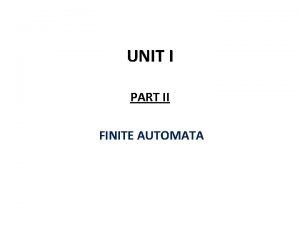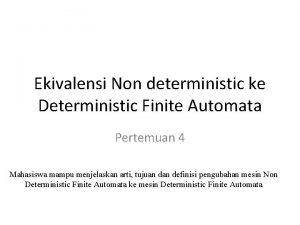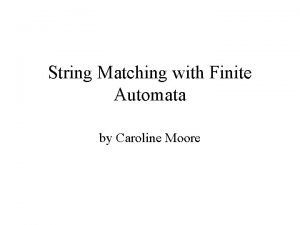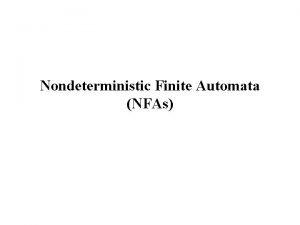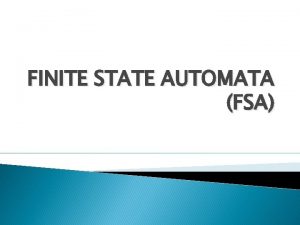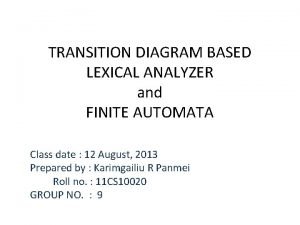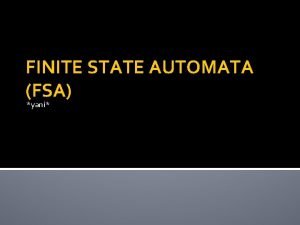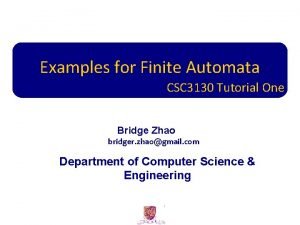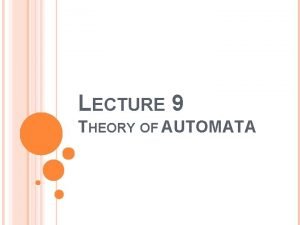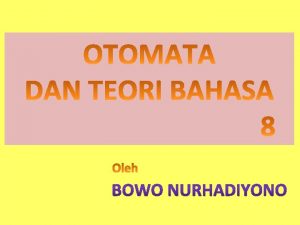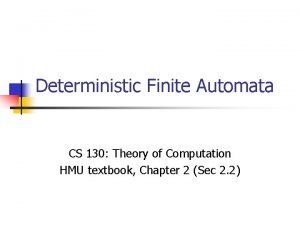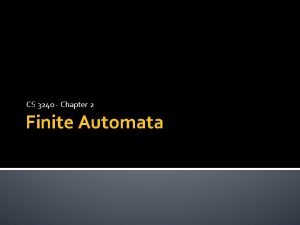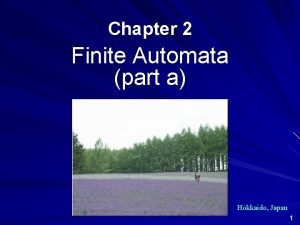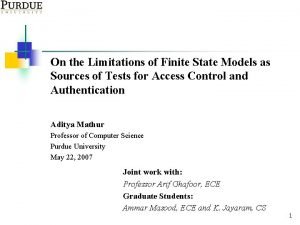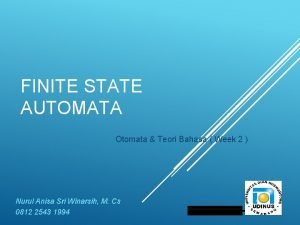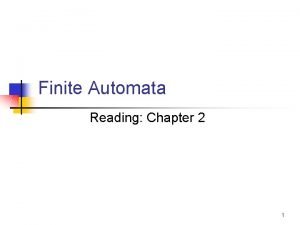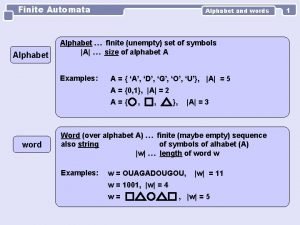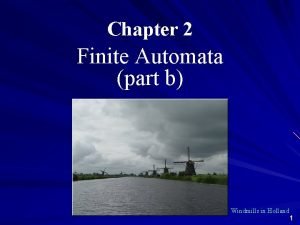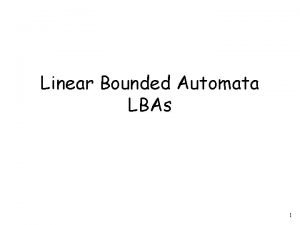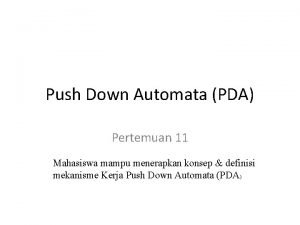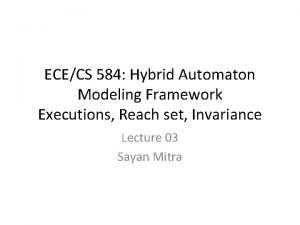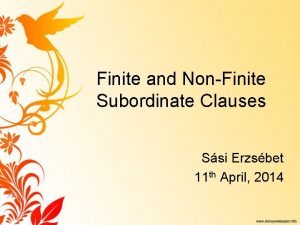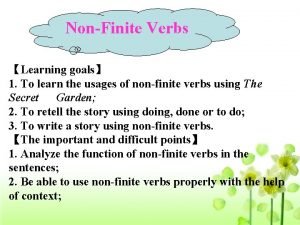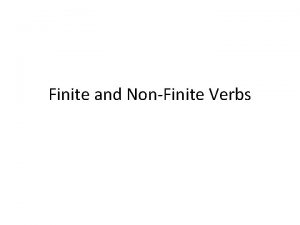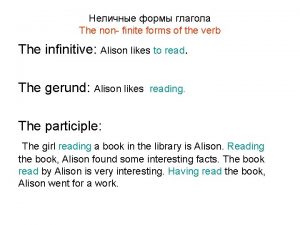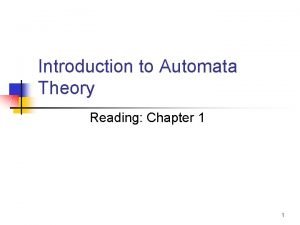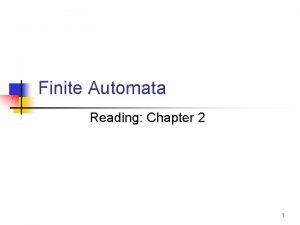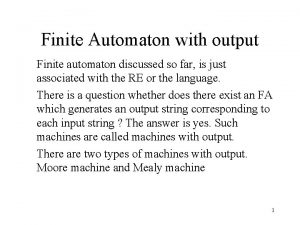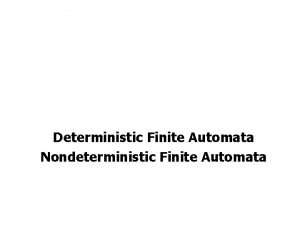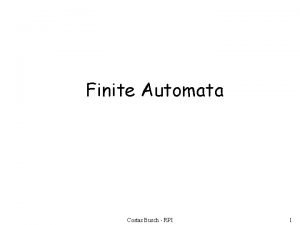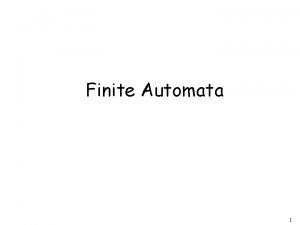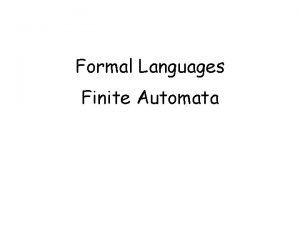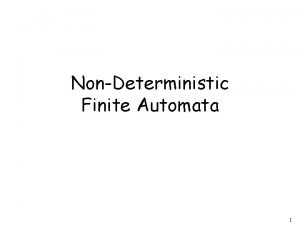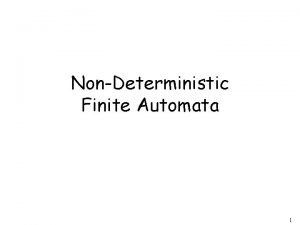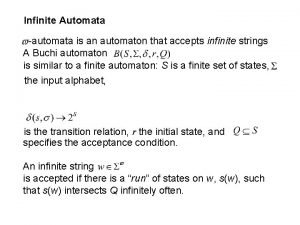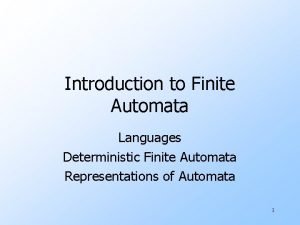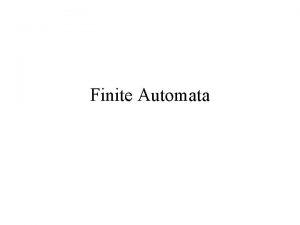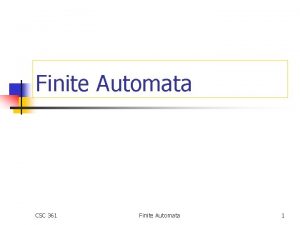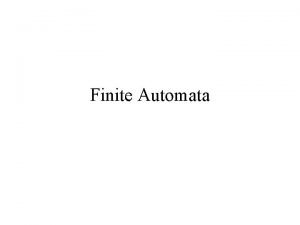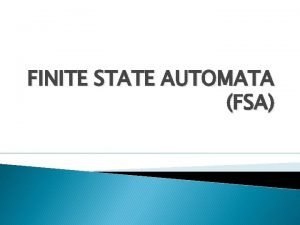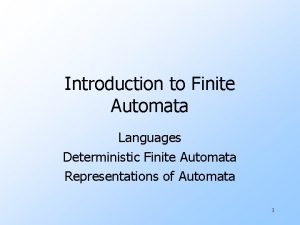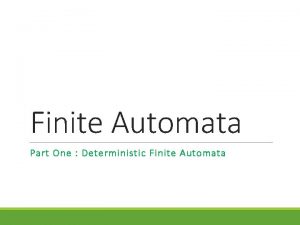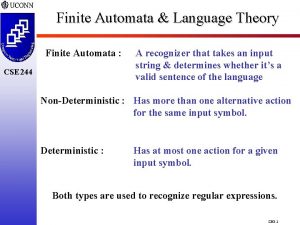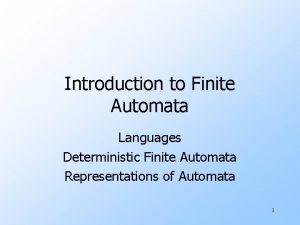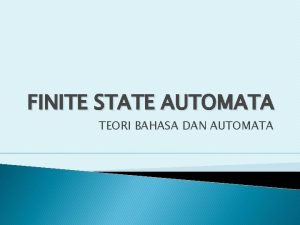Finite Automata Reading Chapter 2 1 Finite Automaton







































- Slides: 39

Finite Automata Reading: Chapter 2 1

Finite Automaton (FA) n Informally, a state diagram that comprehensively captures all possible states and transitions that a machine can take while responding to a stream or sequence of input symbols Recognizer for “Regular Languages” n Deterministic Finite Automata (DFA) n n n The machine can exist in only one state at any given time Non-deterministic Finite Automata (NFA) n The machine can exist in multiple states at the same time 2

Deterministic Finite Automata Definition n A Deterministic Finite Automaton (DFA) consists of: n n n Q ==> a finite set of states ∑ ==> a finite set of input symbols (alphabet) q 0 ==> a start state F ==> set of final states δ ==> a transition function, which is a mapping between Q x ∑ ==> Q A DFA is defined by the 5 -tuple: n {Q, ∑ , q 0, F, δ } 3

What does a DFA do on reading an input string? n n n Input: a word w in ∑* Question: Is w acceptable by the DFA? Steps: n n Start at the “start state” q 0 For every input symbol in the sequence w do n n n Compute the next state from the current state, given the current input symbol in w and the transition function If after all symbols in w are consumed, the current state is one of the final states (F) then accept w; Otherwise, reject w. 4

Regular Languages n Let L(A) be a language recognized by a DFA A. n n Then L(A) is called a “Regular Language”. Locate regular languages in the Chomsky Hierarchy 5

Example #1 n Build a DFA for the following language: n n Steps for building a DFA to recognize L: n n n L = {w | w is a binary string that contains 01 as a substring} ∑ = {0, 1} Decide on the states: Q Designate start state and final state(s) δ: Decide on the transitions: Final states == same as “accepting states” Other states == same as “non-accepting states” 6

Regular expression: (0+1)*01(0+1)* DFA for strings containing 01 • Q = {q 0, q 1, q 2} • What makes this DFA deterministic? start q 0 0, 1 0 0 q 1 1 • ∑ = {0, 1} • start state = q 0 q 2 Final state • What if the language allows empty strings? • F = {q 2} • Transition table symbols states 1 0 1 q 0 q 1 q 2 *q 2 q 2 7

Example #2 Clamping Logic: n n n A clamping circuit waits for a ” 1” input, and turns on forever. However, to avoid clamping on spurious noise, we’ll design a DFA that waits for two consecutive 1 s in a row before clamping on. Build a DFA for the following language: L = { w | w is a bit string which contains the substring 11} State Design: n n n q 0 : start state (initially off), also means the most recent input was not a 1 q 1: has never seen 11 but the most recent input was a 1 q 2: has seen 11 at least once 8

Example #3 n n Build a DFA for the following language: L = { w | w is a binary string that has even number of 1 s and even number of 0 s} ? 9

Extension of transitions (δ) to Paths (δ) n n δ (q, w) = destination state from state q on input string w δ (q, wa) = δ (δ(q, w), a) n Work out example #3 using the input sequence w=10010, a=1: n δ (q 0, wa) = ? 10

Language of a DFA A accepts string w if there is a path from q 0 to an accepting (or final) state that is labeled by w n n i. e. , L(A) = { w | δ(q 0, w) F } I. e. , L(A) = all strings that lead to a final state from q 0 11

Non-deterministic Finite Automata (NFA) n A Non-deterministic Finite Automaton (NFA) n is of course “non-deterministic” n n Implying that the machine can exist in more than one state at the same time Transitions could be non-deterministic qi 1 1 qj … qk • Each transition function therefore maps to a set of states 12

Non-deterministic Finite Automata (NFA) n A Non-deterministic Finite Automaton (NFA) consists of: n n n Q ==> a finite set of states ∑ ==> a finite set of input symbols (alphabet) q 0 ==> a start state F ==> set of final states δ ==> a transition function, which is a mapping between Q x ∑ ==> subset of Q An NFA is also defined by the 5 -tuple: n {Q, ∑ , q 0, F, δ } 13

How to use an NFA? n n n Input: a word w in ∑* Question: Is w acceptable by the NFA? Steps: n n Start at the “start state” q 0 For every input symbol in the sequence w do n n n Determine all possible next states from all current states, given the current input symbol in w and the transition function If after all symbols in w are consumed and if at least one of the current states is a final state then accept w; Otherwise, reject w. 14

Regular expression: (0+1)*01(0+1)* NFA for strings containing 01 Why is this non-deterministic? • Q = {q 0, q 1, q 2} 0, 1 q 0 0 q 1 • start state = q 0 q 2 Final state What will happen if at state q 1 an input of 0 is received? • F = {q 2} • Transition table symbols states start 1 • = {0, 1} 0 1 q 0 {q 0, q 1} {q 0} q 1 Φ {q 2} *q 2 {q 2} 15

Note: Explicitly specifying dead states is just a matter of design convenience (one that is generally followed in NFAs), and this feature does not make a machine deterministic or non-deterministic. What is a “dead state”? n A DFA for recognizing the key word “while” w h i l e q 0 q 1 q 2 q 3 q 4 q 5 Any other input symbol qdead n Any symbol An NFA for the same purpose: q 0 w q 1 h q 2 i q 3 l q 4 e q 5 Transitions into a dead state are implicit 16

Example #2 n n n Build an NFA for the following language: L = { w | w ends in 01} ? Other examples n n Keyword recognizer (e. g. , if, then, else, while, for, include, etc. ) Strings where the first symbol is present somewhere later on at least once 17

Extension of δ to NFA Paths n Basis: δ (q, ) = {q} n Induction: n Let δ (q 0, w) = {p 1, p 2…, pk} δ (pi, a) = Si for i=1, 2. . . , k n Then, δ (q 0, wa) = S 1 U S 2 U … U Sk n 18

Language of an NFA n n An NFA accepts w if there exists at least one path from the start state to an accepting (or final) state that is labeled by w L(N) = { w | δ(q 0, w) ∩ F ≠ Φ } 19

Advantages & Caveats for NFA n Great for modeling regular expressions n n String processing - e. g. , grep, lexical analyzer Could a non-deterministic state machine be implemented in practice? n n A parallel computer could exist in multiple “states” at the same time Probabilistic models could be viewed as extensions of non-deterministic state machines (e. g. , toss of a coin, a roll of dice) 20

But, DFAs and NFAs are equivalent in their power to capture langauges !! Differences: DFA vs. NFA n 1. DFA All transitions are deterministic n 2. 3. 4. 5. n 1. Each transition leads to exactly one state For each state, transition on all possible symbols (alphabet) should be defined Accepts input if the last state is in F Sometimes harder to construct because of the number of states Practical implementation is feasible NFA Some transitions could be non -deterministic n 2. 3. 4. 5. A transition could lead to a subset of states Not all symbol transitions need to be defined explicitly (if undefined will go to a dead state – this is just a design convenience, not to be confused with “nondeterminism”) Accepts input if one of the last states is in F Generally easier than a DFA to construct Practical implementation has to be deterministic (convert to DFA) or in the form of parallelism 21

Equivalence of DFA & NFA Theorem: n Should be true for any L n A language L is accepted by a DFA if and only if it is accepted by an NFA. Proof: n 1. If part: n 2. Prove by showing every NFA can be converted to an equivalent DFA (in the next few slides…) Only-if part is trivial: n Every DFA is a special case of an NFA where each state has exactly one transition for every input symbol. Therefore, if L is accepted by a DFA, it is accepted by a corresponding NFA. 22

Proof for the if-part n n If-part: A language L is accepted by a DFA if it is accepted by an NFA rephrasing… Given any NFA N, we can construct a DFA D such that L(N)=L(D) How to convert an NFA into a DFA? n n Observation: In an NFA, each transition maps to a subset of states Idea: Represent: each “subset of NFA_states” a single “DFA_state” Subset construction 23

NFA to DFA by subset construction Let N = {QN, ∑, δN, q 0, FN} Goal: Build D={QD, ∑, δD, {q 0}, FD} s. t. L(D)=L(N) Construction: n n n 1. 2. 3. QD= all subsets of QN (i. e. , power set) FD=set of subsets S of QN s. t. S∩FN≠Φ δD: for each subset S of QN and for each input symbol a in ∑: n δD(S, a) = U δN(p, a) p in s 24

Idea: To avoid enumerating all of power set, do “lazy creation of states” NFA to DFA construction: Example L = {w | w ends in 01} n NFA: DFA: 0, 1 q 0 1 0 q 1 1 0 {q 0} 0 {q 0, q 1} 1 0 {q 0, q 2} 1 q 2 δD 0 1 Ø Ø Ø {q 0} {q 0, q 1} {q 0} {q 0, q 1} {q 0, q 2} Ø {q 2} {q 1} Ø {q 2} *{q 0, q 2} {q 0, q 1} {q 0} Ø Ø *{q 2} Ø Ø {q 0, q 1} {q 0, q 2} *{q 0, q 2} {q 0, q 1} {q 0} 0. Enumerate all possible subsets *{q 1, q 2} Ø {q 2} *{q 0, q 1, q 2} {q 0, q 1} {q 0, q 2} 1. 2. Determine transitions Retain only those states reachable from {q 0} 25 δN 0 1 q 0 {q 0, q 1} q 1 *q 2

NFA to DFA: Repeating the example using LAZY CREATION L = {w | w ends in 01} n NFA: DFA: 0, 1 q 0 1 0 q 1 1 0 {q 0} 0 {q 0, q 1} 1 0 {q 0, q 2} 1 q 2 δN 0 1 δD 0 1 q 0 {q 0, q 1} {q 0} q 1 Ø {q 2} {q 0, q 1} {q 0, q 2} *q 2 Ø Ø *{q 0, q 2} {q 0, q 1} {q 0} Main Idea: Introduce states as you go (on a need basis) 26

Correctness of subset construction Theorem: If D is the DFA constructed from NFA N by subset construction, then L(D)=L(N) n Proof: n n Show that δD({q 0}, w) ≡ δN(q 0, w} , for all w Using induction on w’s length: n n Let w = xa δD({q 0}, xa) ≡ δD( δN(q 0, x}, a ) ≡ δN(q 0, w} 27

A bad case where #states(DFA)>>#states(NFA) n L = {w | w is a binary string s. t. , the kth symbol from its end is a 1} n n NFA has k+1 states But an equivalent DFA needs to have at least 2 k states (Pigeon hole principle) n m holes and >m pigeons n => at least one hole has to contain two or more pigeons 28

Applications n Text indexing n n n Find pattern P in text T n n inverted indexing For each unique word in the database, store all locations that contain it using an NFA or a DFA Example: Google querying Extensions of this idea: n PATRICIA tree, suffix tree 29

A few subtle properties of DFAs and NFAs n n The machine never really terminates. n It is always waiting for the next input symbol or making transitions. The machine decides when to consume the next symbol from the input and when to ignore it. n (but the machine can never skip a symbol) => A transition can happen even without really consuming an input symbol (think of consuming as a free token) A single transition cannot consume more than one symbol. 30

FA with -Transitions n We can allow explicit -transitions in finite automata n n i. e. , a transition from one state to another state without consuming any additional input symbol Makes it easier sometimes to construct NFAs Definition: -NFAs are those NFAs with at least one explicit -transition defined. n -NFAs have one more column in their transition table 31

Example of an -NFA L = {w | w is empty, or if non-empty will end in 01} 0, 1 start q 0 0 q 1 1 n q 2 q’ 0 δE 0 1 *q’ 0 Ø Ø {q’ 0, q 0} q 0 {q 0, q 1} {q 0} q 1 Ø {q 2} {q 1} *q 2 Ø Ø {q 2} ECLOSE(q’ 0) ECLOSE(q 1) ECLOSE(q 2) -closure of a state q, ECLOSE(q), is the set of all states (including itself) that can be reached from q by repeatedly making an arbitrary number of transitions. 32

To simulate any transition: Step 1) Go to all immediate destination states. Step 2) From there go to all their -closure states as well. Example of an -NFA L = {w | w is empty, or if non-empty will end in 01} 0, 1 start q 0 0 q 1 1 Simulate for w=101: q 2 q’ 0 1 δE 0 1 *q’ 0 Ø Ø {q’ 0, q 0} q 0 {q 0, q 1} {q 0} q 1 Ø {q 2} {q 1} *q 2 Ø Ø {q 2} q 0 ’ Ø ECLOSE(q’ 0) ECLOSE(q 0) x q 0 ’ q 0 1 q 0 0 q 1 1 q 2 33

To simulate any transition: Step 1) Go to all immediate destination states. Step 2) From there go to all their -closure states as well. Example of another -NFA 0, 1 q 0 start 0 q 1 1 1 q 2 Simulate for w=101: ? q 3 q’ 0 δE 0 1 *q’ 0 Ø Ø {q’ 0, q 3} q 0 {q 0, q 1} {q 0, q 3} q 1 Ø {q 2} {q 1} *q 2 Ø Ø {q 2} q 3 Ø {q 2} {q 3} 34

Equivalency of DFA, NFA, -NFA n Theorem: A language L is accepted by some -NFA if and only if L is accepted by some DFA n Implication: n n DFA ≡ NFA ≡ -NFA (all accept Regular Languages) 35

Eliminating -transitions Let E = {QE, ∑, δE, q 0, FE} be an -NFA Goal: To build DFA D={QD, ∑, δD, {q. D}, FD} s. t. L(D)=L(E) Construction: 1. 2. 3. 4. QD= all reachable subsets of QE factoring in -closures q. D = ECLOSE(q 0) FD=subsets S in QD s. t. S∩FE≠Φ δD: for each subset S of QE and for each input symbol a ∑: n Let R= U δE(p, a) // go to destination states δD(S, a) = U ECLOSE(r) // from there, take a union of all their -closures p in s n r in R Reading: Section 2. 5. 5 in book 36

Example: -NFA DFA L = {w | w is empty, or if non-empty will end in 01} 0, 1 start 0 q 1 1 q 2 q’ 0 δE 0 1 δD *q’ 0 Ø Ø {q’ 0, q 0} *{q’ 0, q 0} q 0 {q 0, q 1} {q 0} … q 1 Ø {q 2} {q 1} *q 2 Ø Ø {q 2} 0 1 37

Example: -NFA DFA L = {w | w is empty, or if non-empty will end in 01} 0 0, 1 start 0 q 1 1 q 2 0 start q’ 0 union {q’ 0, q 0} 0 {q 0, q 1} 0 1 union 1 {q 0, q 2} 1 q 0 δE 0 1 δD 0 1 *q’ 0 Ø Ø {q’ 0, q 0} *{q’ 0, q 0} {q 0, q 1} {q 0} q 0 {q 0, q 1} {q 0} {q 0, q 1} {q 0, q 2} q 1 Ø {q 2} {q 1} {q 0, q 1} {q 0} *q 2 Ø Ø {q 2} *{q 0, q 2} {q 0, q 1} {q 0} 1 38

Summary n DFA n Definition n Transition diagrams & tables Regular language NFA n Definition n Transition diagrams & tables DFA vs. NFA to DFA conversion using subset construction Equivalency of DFA & NFA Removal of redundant states and including dead states n -transitions in NFA n n n n Pigeon hole principles Text searching applications 39
 Dfa stands for in automata
Dfa stands for in automata Ekivalensi
Ekivalensi Contoh soal teori bahasa dan automata
Contoh soal teori bahasa dan automata String matching with finite automata
String matching with finite automata Finite automata
Finite automata Diagram fsa
Diagram fsa Lexical analysis finite automata
Lexical analysis finite automata Finite automata generator
Finite automata generator Fsa diagram
Fsa diagram Automata
Automata Kleene's theorem part 2
Kleene's theorem part 2 Gambarkan graf transisi berdasarkan pendekatan mesin moore
Gambarkan graf transisi berdasarkan pendekatan mesin moore Theory of computation
Theory of computation Finite automata
Finite automata An informal picture of finite automata
An informal picture of finite automata Contoh tata bahasa reguler
Contoh tata bahasa reguler Limitations of finite automata
Limitations of finite automata Finite automata
Finite automata Deterministic finite state automata
Deterministic finite state automata Gambarlah diagram transisi untuk nfa berikut
Gambarlah diagram transisi untuk nfa berikut Finite automata
Finite automata Unempty
Unempty Finite automata with epsilon transitions
Finite automata with epsilon transitions Suffix automaton
Suffix automaton The class of lba is countable.
The class of lba is countable. Contoh pda
Contoh pda Hybrid automaton
Hybrid automaton Pre reading while reading and post reading activities
Pre reading while reading and post reading activities Non finite subordinate clause
Non finite subordinate clause Learning objectives for finite and non finite verbs
Learning objectives for finite and non finite verbs Learning objectives of non finite verbs
Learning objectives of non finite verbs How to find finite and nonfinite verbs
How to find finite and nonfinite verbs Non finite forms of the verb qayda
Non finite forms of the verb qayda Turing machine algorithm
Turing machine algorithm Round robin reading vs popcorn reading
Round robin reading vs popcorn reading Reading aims
Reading aims Characteristics of skimming reading
Characteristics of skimming reading Guided reading vs shared reading
Guided reading vs shared reading Critical reading active process of discovery
Critical reading active process of discovery Intensive reading and extensive reading
Intensive reading and extensive reading
